Hongyan Li
CodeContests+: High-Quality Test Case Generation for Competitive Programming
Jun 06, 2025Abstract:Competitive programming, due to its high reasoning difficulty and precise correctness feedback, has become a key task for both training and evaluating the reasoning capabilities of large language models (LLMs). However, while a large amount of public problem data, such as problem statements and solutions, is available, the test cases of these problems are often difficult to obtain. Therefore, test case generation is a necessary task for building large-scale datasets, and the quality of the test cases directly determines the accuracy of the evaluation. In this paper, we introduce an LLM-based agent system that creates high-quality test cases for competitive programming problems. We apply this system to the CodeContests dataset and propose a new version with improved test cases, named CodeContests+. We evaluated the quality of test cases in CodeContestsPlus. First, we used 1.72 million submissions with pass/fail labels to examine the accuracy of these test cases in evaluation. The results indicated that CodeContests+ achieves significantly higher accuracy than CodeContests, particularly with a notably higher True Positive Rate (TPR). Subsequently, our experiments in LLM Reinforcement Learning (RL) further confirmed that improvements in test case quality yield considerable advantages for RL.
T2S: High-resolution Time Series Generation with Text-to-Series Diffusion Models
May 05, 2025Abstract:Text-to-Time Series generation holds significant potential to address challenges such as data sparsity, imbalance, and limited availability of multimodal time series datasets across domains. While diffusion models have achieved remarkable success in Text-to-X (e.g., vision and audio data) generation, their use in time series generation remains in its nascent stages. Existing approaches face two critical limitations: (1) the lack of systematic exploration of general-proposed time series captions, which are often domain-specific and struggle with generalization; and (2) the inability to generate time series of arbitrary lengths, limiting their applicability to real-world scenarios. In this work, we first categorize time series captions into three levels: point-level, fragment-level, and instance-level. Additionally, we introduce a new fragment-level dataset containing over 600,000 high-resolution time series-text pairs. Second, we propose Text-to-Series (T2S), a diffusion-based framework that bridges the gap between natural language and time series in a domain-agnostic manner. T2S employs a length-adaptive variational autoencoder to encode time series of varying lengths into consistent latent embeddings. On top of that, T2S effectively aligns textual representations with latent embeddings by utilizing Flow Matching and employing Diffusion Transformer as the denoiser. We train T2S in an interleaved paradigm across multiple lengths, allowing it to generate sequences of any desired length. Extensive evaluations demonstrate that T2S achieves state-of-the-art performance across 13 datasets spanning 12 domains.
DiffuSETS: 12-lead ECG Generation Conditioned on Clinical Text Reports and Patient-Specific Information
Jan 10, 2025Abstract:Heart disease remains a significant threat to human health. As a non-invasive diagnostic tool, the electrocardiogram (ECG) is one of the most widely used methods for cardiac screening. However, the scarcity of high-quality ECG data, driven by privacy concerns and limited medical resources, creates a pressing need for effective ECG signal generation. Existing approaches for generating ECG signals typically rely on small training datasets, lack comprehensive evaluation frameworks, and overlook potential applications beyond data augmentation. To address these challenges, we propose DiffuSETS, a novel framework capable of generating ECG signals with high semantic alignment and fidelity. DiffuSETS accepts various modalities of clinical text reports and patient-specific information as inputs, enabling the creation of clinically meaningful ECG signals. Additionally, to address the lack of standardized evaluation in ECG generation, we introduce a comprehensive benchmarking methodology to assess the effectiveness of generative models in this domain. Our model achieve excellent results in tests, proving its superiority in the task of ECG generation. Furthermore, we showcase its potential to mitigate data scarcity while exploring novel applications in cardiology education and medical knowledge discovery, highlighting the broader impact of our work.
Retrieval-Augmented Diffusion Models for Time Series Forecasting
Oct 24, 2024
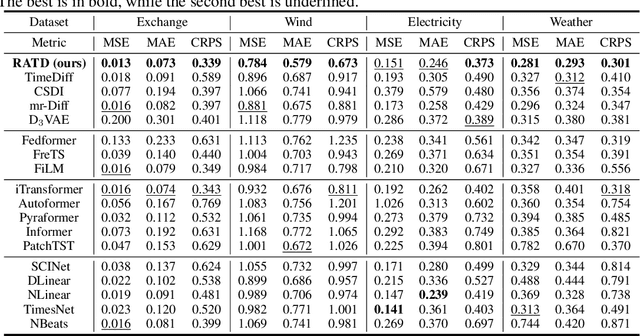


Abstract:While time series diffusion models have received considerable focus from many recent works, the performance of existing models remains highly unstable. Factors limiting time series diffusion models include insufficient time series datasets and the absence of guidance. To address these limitations, we propose a Retrieval- Augmented Time series Diffusion model (RATD). The framework of RATD consists of two parts: an embedding-based retrieval process and a reference-guided diffusion model. In the first part, RATD retrieves the time series that are most relevant to historical time series from the database as references. The references are utilized to guide the denoising process in the second part. Our approach allows leveraging meaningful samples within the database to aid in sampling, thus maximizing the utilization of datasets. Meanwhile, this reference-guided mechanism also compensates for the deficiencies of existing time series diffusion models in terms of guidance. Experiments and visualizations on multiple datasets demonstrate the effectiveness of our approach, particularly in complicated prediction tasks.
Re-TASK: Revisiting LLM Tasks from Capability, Skill, and Knowledge Perspectives
Aug 13, 2024Abstract:As large language models (LLMs) continue to scale, their enhanced performance often proves insufficient for solving domain-specific tasks. Systematically analyzing their failures and effectively enhancing their performance remain significant challenges. This paper introduces the Re-TASK framework, a novel theoretical model that Revisits LLM Tasks from cApability, Skill, Knowledge perspectives, guided by the principles of Bloom's Taxonomy and Knowledge Space Theory. The Re-TASK framework provides a systematic methodology to deepen our understanding, evaluation, and enhancement of LLMs for domain-specific tasks. It explores the interplay among an LLM's capabilities, the knowledge it processes, and the skills it applies, elucidating how these elements are interconnected and impact task performance. Our application of the Re-TASK framework reveals that many failures in domain-specific tasks can be attributed to insufficient knowledge or inadequate skill adaptation. With this insight, we propose structured strategies for enhancing LLMs through targeted knowledge injection and skill adaptation. Specifically, we identify key capability items associated with tasks and employ a deliberately designed prompting strategy to enhance task performance, thereby reducing the need for extensive fine-tuning. Alternatively, we fine-tune the LLM using capability-specific instructions, further validating the efficacy of our framework. Experimental results confirm the framework's effectiveness, demonstrating substantial improvements in both the performance and applicability of LLMs.
Review of Data-centric Time Series Analysis from Sample, Feature, and Period
Apr 24, 2024Abstract:Data is essential to performing time series analysis utilizing machine learning approaches, whether for classic models or today's large language models. A good time-series dataset is advantageous for the model's accuracy, robustness, and convergence, as well as task outcomes and costs. The emergence of data-centric AI represents a shift in the landscape from model refinement to prioritizing data quality. Even though time-series data processing methods frequently come up in a wide range of research fields, it hasn't been well investigated as a specific topic. To fill the gap, in this paper, we systematically review different data-centric methods in time series analysis, covering a wide range of research topics. Based on the time-series data characteristics at sample, feature, and period, we propose a taxonomy for the reviewed data selection methods. In addition to discussing and summarizing their characteristics, benefits, and drawbacks targeting time-series data, we also introduce the challenges and opportunities by proposing recommendations, open problems, and possible research topics.
Macroscopic auxiliary asymptotic preserving neural networks for the linear radiative transfer equations
Mar 04, 2024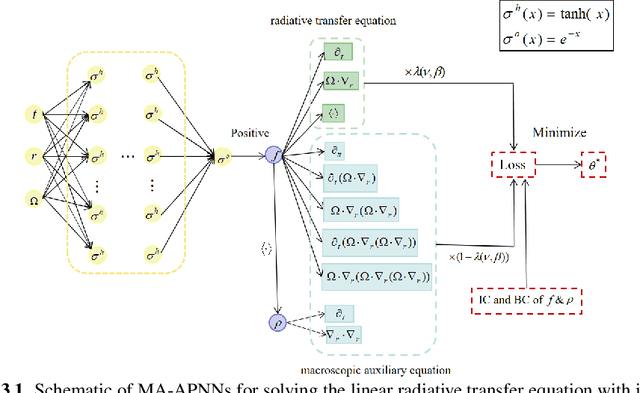



Abstract:We develop a Macroscopic Auxiliary Asymptotic-Preserving Neural Network (MA-APNN) method to solve the time-dependent linear radiative transfer equations (LRTEs), which have a multi-scale nature and high dimensionality. To achieve this, we utilize the Physics-Informed Neural Networks (PINNs) framework and design a new adaptive exponentially weighted Asymptotic-Preserving (AP) loss function, which incorporates the macroscopic auxiliary equation that is derived from the original transfer equation directly and explicitly contains the information of the diffusion limit equation. Thus, as the scale parameter tends to zero, the loss function gradually transitions from the transport state to the diffusion limit state. In addition, the initial data, boundary conditions, and conservation laws serve as the regularization terms for the loss. We present several numerical examples to demonstrate the effectiveness of MA-APNNs.
Curricular and Cyclical Loss for Time Series Learning Strategy
Dec 26, 2023Abstract:Time series widely exists in real-world applications and many deep learning models have performed well on it. Current research has shown the importance of learning strategy for models, suggesting that the benefit is the order and size of learning samples. However, no effective strategy has been proposed for time series due to its abstract and dynamic construction. Meanwhile, the existing one-shot tasks and continuous tasks for time series necessitate distinct learning processes and mechanisms. No all-purpose approach has been suggested. In this work, we propose a novel Curricular and CyclicaL loss (CRUCIAL) to learn time series for the first time. It is model- and task-agnostic and can be plugged on top of the original loss with no extra procedure. CRUCIAL has two characteristics: It can arrange an easy-to-hard learning order by dynamically determining the sample contribution and modulating the loss amplitude; It can manage a cyclically changed dataset and achieve an adaptive cycle by correlating the loss distribution and the selection probability. We prove that compared with monotonous size, cyclical size can reduce expected error. Experiments on 3 kinds of tasks and 5 real-world datasets show the benefits of CRUCIAL for most deep learning models when learning time series.
TEST: Text Prototype Aligned Embedding to Activate LLM's Ability for Time Series
Aug 16, 2023



Abstract:This work summarizes two strategies for completing time-series (TS) tasks using today's language model (LLM): LLM-for-TS, design and train a fundamental large model for TS data; TS-for-LLM, enable the pre-trained LLM to handle TS data. Considering the insufficient data accumulation, limited resources, and semantic context requirements, this work focuses on TS-for-LLM methods, where we aim to activate LLM's ability for TS data by designing a TS embedding method suitable for LLM. The proposed method is named TEST. It first tokenizes TS, builds an encoder to embed them by instance-wise, feature-wise, and text-prototype-aligned contrast, and then creates prompts to make LLM more open to embeddings, and finally implements TS tasks. Experiments are carried out on TS classification and forecasting tasks using 8 LLMs with different structures and sizes. Although its results cannot significantly outperform the current SOTA models customized for TS tasks, by treating LLM as the pattern machine, it can endow LLM's ability to process TS data without compromising the language ability. This paper is intended to serve as a foundational work that will inspire further research.
A model-data asymptotic-preserving neural network method based on micro-macro decomposition for gray radiative transfer equations
Dec 11, 2022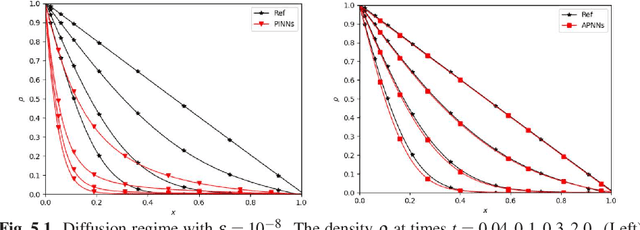

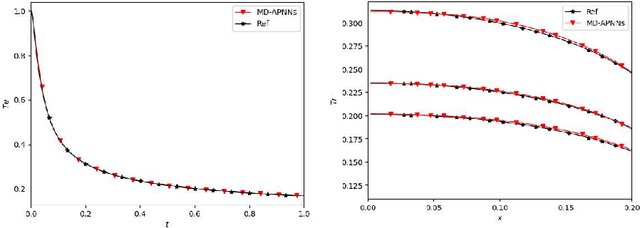
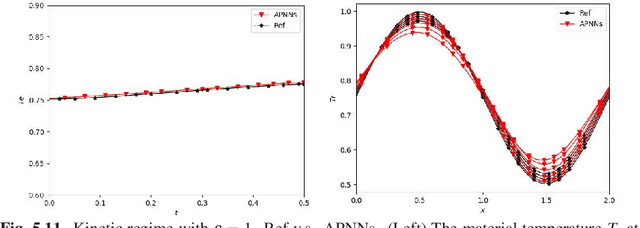
Abstract:We propose a model-data asymptotic-preserving neural network(MD-APNN) method to solve the nonlinear gray radiative transfer equations(GRTEs). The system is challenging to be simulated with both the traditional numerical schemes and the vanilla physics-informed neural networks(PINNs) due to the multiscale characteristics. Under the framework of PINNs, we employ a micro-macro decomposition technique to construct a new asymptotic-preserving(AP) loss function, which includes the residual of the governing equations in the micro-macro coupled form, the initial and boundary conditions with additional diffusion limit information, the conservation laws, and a few labeled data. A convergence analysis is performed for the proposed method, and a number of numerical examples are presented to illustrate the efficiency of MD-APNNs, and particularly, the importance of the AP property in the neural networks for the diffusion dominating problems. The numerical results indicate that MD-APNNs lead to a better performance than APNNs or pure data-driven networks in the simulation of the nonlinear non-stationary GRTEs.
 Add to Chrome
Add to Chrome Add to Firefox
Add to Firefox Add to Edge
Add to Edge